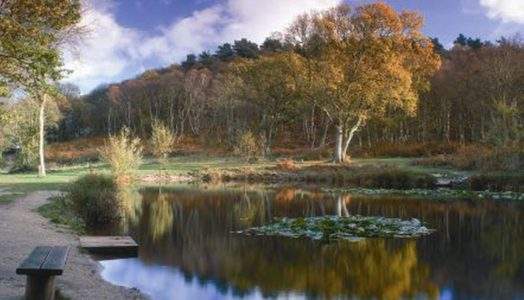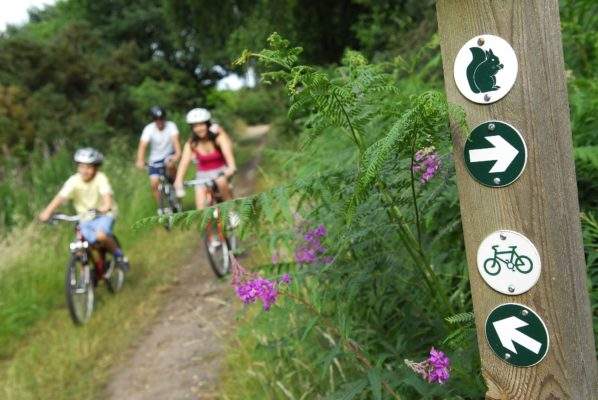The Night Sky At Kelling Heath
KELLING HEATH - A DARK SKY DISCOVERY SITE
Official recognition has come at last that Kelling Heath Holiday Park is one of the best places in England to discover the dark and enjoy starry skies.
Following an application by the Norfolk Coast Partnership, Kelling Heath in north Norfolk was awarded ‘Dark Sky Discovery Site' status in September 2017.
Kelling Heath has met the strict criteria set by the UK Dark Sky Discovery partnership of being an exceptionally dark site, unaffected by light pollution and accessible for people to view the night sky. Kelling has the highest accolade of being designated a ‘two-star' site - where the seven stars of the Orion constellation and the Milky Way are visible to the naked eye.
Kelling Heath joins a network of around 150 such sites throughout the UK, and - along with Wiveton Downs and Great Ellingham - they become part of three such sites in Norfolk to be listed.
The designation comes from the Dark Sky Discovery partnership, led by the UK's Science and Technology Facilities Council, which includes the Royal Astronomical Society and the Institute of Physics amongst its members.
Dark Sky Discovery Sites:
- Are away from local light pollution.
- Provide good sightlines of the horizon.
- Are easily and freely accessible at all times.
- Are dark enough to observe the seven stars of the Orion constellation (One Star site) or The Milky Way (a darker, Two Star site) with the naked eye.
Click here for more information about Dark Sky Discovery Sites.
The benefits of darkness:
- Allows natural behaviours of wildlife - foraging, breeding, seasonal adaption and migration, and crop growth.
- Regulates the body clock through the release of melatonin hormone, which occurs at night.
- Improves mental health and wellbeing.
- Without sight as your primary aid, your other senses (hearing, smell) become enhanced.
- You can feel closer to nature.
- Stars are visible for astronomers and amateurs alike to enjoy.
The UK Dark Sky Discovery partnership is led by the UK's Science and Technology Facilities Council. Its other members are the Royal Astronomical Society, the Federation of Astronomical Societies, the Society for Popular Astronomy, the British Association of Planetaria, the Institute of Physics, the Campaign for Dark Skies, and the UK Association for Science and Discovery Centres.
Pick up your free ‘Stargazing Starchart Guide' from Reception and follow the waymark signs to Kelling Heath's Dark Sky Discovery Site.
Visitors to the Kelling Heath Holiday Park in North Norfolk may have noticed the stunning night skies the Park has to offer. Many UK astronomers certainly have, and to take advantage of this, they organise twice-yearly star parties. These gatherings are attended by hundreds of astronomers from all over the country, and the Autumn event is thought to be the largest star party in Europe.
Situated in the heart of the North Norfolk countryside, Kelling Heath is well away from any intrusive lighting which allows the Park to enjoy some of the darkest sites in the country. Kelling Heath plays its part in keeping light pollution to a minimum through the sensitive use of nighttime lighting. Astronomers recognise that light is needed for safety, as do the owners of Kelling Heath, but they also recognise the impact poor lighting can have on the night sky and strive to help protect it for future generations.
For many people across the country, artificial lighting shines into the sky, bounces off tiny particles in the atmosphere (from industrial activity), and scatters the light back down to the Earth as light pollution. This has the effect of brightening the night sky, rendering many fainter objects invisible. Indeed, for a vast proportion of the population, it is not possible to see the glorious sight of the Milky Way arching overhead.
Because Norfolk is a rural county, industrial activity is sparse. Pollutants pumped into the air from such installations can lead to a serious reduction in the clarity of the night sky. As a result, clear night skies at Kelling Heath allow visitors an unrivalled view of the night sky for this part of the UK. Campers will be able to marvel not only at the Milky Way (the combined light from the millions of stars in our Galaxy) but will be able to search around the many dark rifts from huge interstellar dust clouds, search out elusive galaxies they have never seen before and enjoy crystal clear views of our planetary neighbours.
Kelling Heath is one of the best areas in the country for astronomy, where the night sky is a precious and cherished part of the camping experience, and is protected for all to enjoy.
Links:
DON'T FORGET YOUR TOOTHBRUSH AND YOUR TORCH!
To help reduce light pollution and maximise the enjoyment of the night sky, lighting at Kelling Heath is kept to the main public areas and touring amenity buildings. Guests may wish to bring torches for their own convenience.
Holidaymakers wanting to book a stay at Norfolk's award-winning Kelling Heath Holiday Park are given somewhat unusual advice - don't forget your torch.
The suggestion is made in Kelling Heath's promotion and highlights just how far the park will go to offer guests a truly special holiday in a setting that has won top environmental awards in recent years.
Kelling Heath Holiday Park has a very specific policy on external lighting anywhere - there isn't any, except its Village Square! The park adjoins Kelling Heath, which is a Site of Special Scientific Interest. The very character of heathland is low-growing vegetation with long, open, expansive views and Kelling Heath is one of the few areas in Norfolk where it can feel as though you have ventured into the 'wilderness'.
The Park's countryside consultant, Kevin Hart, says there are three main reasons why Kelling resists bringing in street and path lighting:
"The visual impact that lighting would have on the Park's areas of heath and Kelling Heath itself would be dramatic and detrimental. The light pollution would be seen over a large area and would vastly diminish the heath's character of wildness. The heathland is very important to the Park both in its wildlife and natural character - and therefore its qualities are rigorously protected."
"We also take great pride in the fact that the night sky seen from the site is unspoilt and spectacular. Some of our nighttime wildlife walks looking for bats or Nightjars pause to take in a bit of astronomy, looking at the differences between stars, planets and even some of the satellites that can be seen moving across the sky. Lighting on the Park would pollute the night sky so that these stars and the associated constellations would be far less visible."
Mr Hart says that the Park is hugely popular with visitors and that lighting is commonly not a part of the Norfolk landscape:
"Lights would suburbanise the woodland and heathland, changing the atmosphere and ambience that people travel from all over the country to experience."
"It seems a small price to pay - by carrying a torch, a large piece of the Norfolk Countryside is protected from losing its beautiful night sky and wonderful rural character."
STARGAZER VIDEO CLIP
Watch our 'Stargazer' video clip here.






